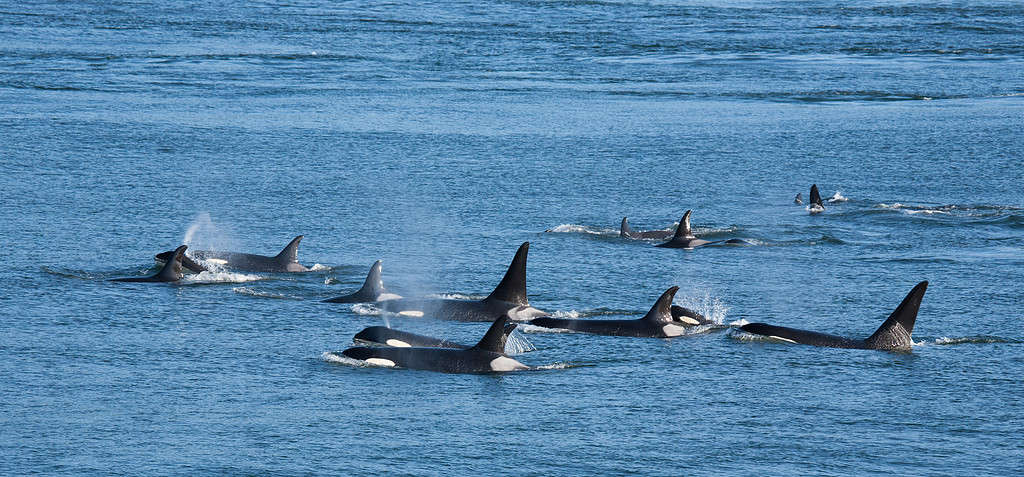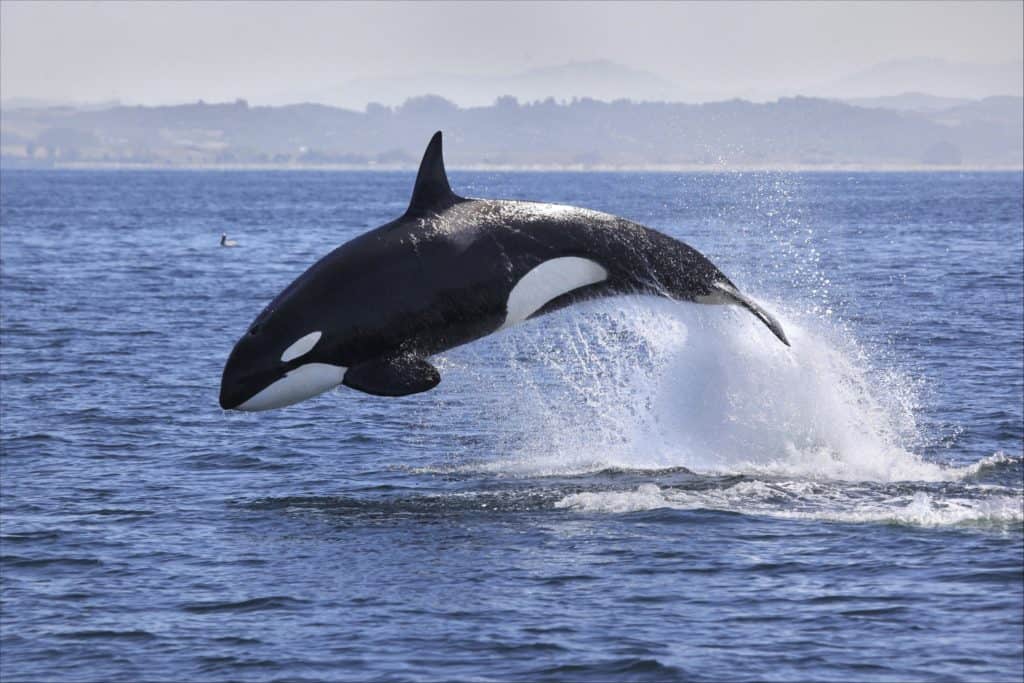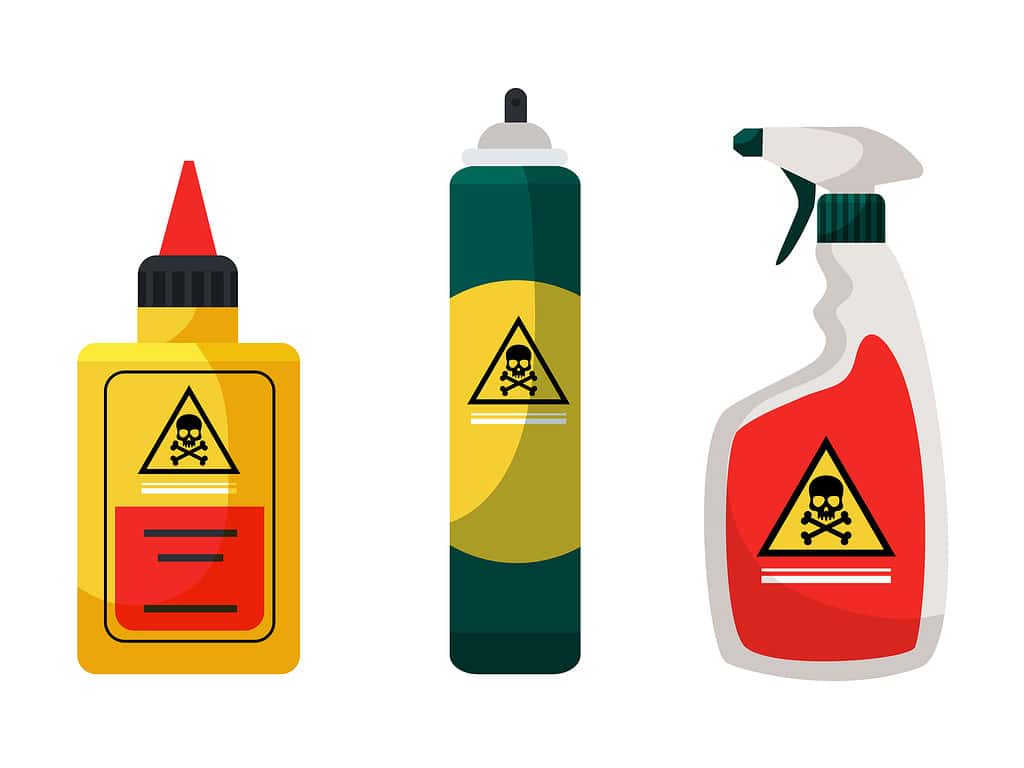The question of “Are orcas endangered?” echoes across the global universe. People actively draw attention to the critical state of these magnificent marine creatures with good reason.
Orcas, also known as killer whales, have long captured the fascination of humans with their intelligence, social bonds, and striking appearances.
However, beneath their awe-inspiring surface lies a tale of vulnerability.
In this article, we delve deep into the current status of orcas, exploring the factors that place them on the precipice of endangerment.
From the challenges posed by toxic contaminants and habitat destruction to the far-reaching impacts of climate change, we dissect the threats that imperil orca populations worldwide.
Yet, amid these challenges, there is hope – a ray of optimism illuminated by conservation efforts, research initiatives, and advocacy to safeguard these iconic marine mammals.
Recognizing the Orca

A pod of orcas in British Columbia, Canada. Their classic markings make them easy to identify.
©iStock.com/cullenphotos
Distinctive Appearance
Orcas, scientifically known as Orcinus orca, are instantly recognizable by their striking black and white coloration. They possess a sleek, torpedo-shaped body that glides effortlessly through the water.
Distinctive Markings
Their black backs and white undersides create a sharp contrast, making them stand out against the ocean’s surface. Some individuals have unique gray or white patches, called “saddle patches,” just behind their dorsal fins.
Iconic Dorsal Fin
One of the most distinctive features of orcas is their dorsal fin. It can tower up to six feet (1.8 meters) in height and is often used to distinguish individual orcas. In some populations, the dorsal fin of males can have a distinct curve or bend.
Impressive Size
Orcas are among the largest marine mammals, with adults reaching lengths of up to 30 feet (9 meters) and weighing as much as 10 tons. This sheer size commands respect and awe.
Powerful Tail Flukes
Their tail flukes, which can span up to 6 feet (1.8 meters) horizontally, are another distinctive feature. These muscular appendages permit powerful propulsion through the water.
Keen Intelligence
Beyond those striking appearances, orcas display a remarkable intelligence. They have large brains relative to their body size, rivaling those of great apes, and exhibit complex social behaviors and communication.
White Eye Patch
Orcas have a white eye patch located just behind their eyes, which adds to their unique facial markings.
Distinctive Vocalizations
Orcas make a wide range of vocalizations, including clicks, whistles, and pulsed calls. Each pod has its unique dialect, contributing to their remarkable ability to communicate with one another.
Remarkable Echo-Location
These intelligent creatures also employ echolocation, emitting sounds that bounce off objects, helping them navigate and locate prey with astonishing precision.
The Orca’s Habitat and Ecological Importance

Orcas prefer deep and cold ocean habitats.
©slowmotiongli/Shutterstock.com
Whales, like Orcas, are remarkable marine mammals with a global presence, demonstrating their adaptability in diverse oceanic climates.
Orcas in Their Habitat
Orcas are highly adaptable creatures, inhabiting oceans across a wide range of latitudes, from the frigid Arctic to the icy waters of the Antarctic.
This adaptability showcases their remarkable ability to thrive in various climates and conditions. You can spot them near coastlines and in open waters, underscoring their status as global residents.
Population Status
Estimating the precise number of orcas in the world remains a challenge. However, experts estimate around 50,000 orcas roam the oceans.
Endangered Status
While orcas are not considered globally endangered, certain populations face severe threats due to habitat degradation and pollution.
One such example is the Southern Resident orcas, which are critically endangered.
Protection for Orcas
To safeguard these magnificent creatures and recognize their vital role in marine ecosystems, many countries have enacted laws and established protected areas and marine reserves.
Let’s take a look at some examples of countries with laws protecting orcas and the potential penalties for violating these laws:
- United States:
- The Marine Mammal Protection Act (MMPA) and the Endangered Species Act (ESA) provide protection to orcas in U.S. waters.
- Violating the MMPA can result in fines of up to $28,520 per violation, civil penalties, and even imprisonment in some cases.
- Canada:
- Canada has laws such as the Species at Risk Act (SARA) and the Marine Mammal Regulations to protect orcas.
- Penalties in Canada may include fines of up to $500,000 for individuals and $1,000,000 for corporations, along with the possibility of imprisonment.
- Australia:
- Australia’s Environment Protection and Biodiversity Conservation Act 1999 (EPBC Act) safeguards marine mammals, including orcas.
- Penalties for violations under the EPBC Act range from fines to imprisonment, depending on the severity of the offense.
- New Zealand:
- New Zealand’s Wildlife Act and the Marine Mammals Protection Act offer legal protection for orcas in its waters.
- Violations may result in fines, imprisonment, and the confiscation of equipment used in illegal activities.
- Norway:
- Norway has regulations under the Nature Diversity Act to protect marine mammals like orcas.
- Penalties for violating these regulations can include fines, imprisonment, and the forfeiture of vessels and equipment used in illegal activities.
It’s crucial to note that the specific penalties for violating these laws vary based on factors such as the severity of the offense and whether it relates to hunting, harassment, or habitat protection.
International agreements and conventions, such as CITES, also contribute to orca protection.
The Orca’s Role in the Ecosystem and Biodiversity

Orcas swim miles to find prey.
©Tory Kallman/Shutterstock.com
Orcas are often referred to as “keystone predators” due to their vital contribution to maintaining the balance and diversity of marine ecosystems.
Keystone predators have a disproportionate impact on their ecosystems, much like a keystone holds an arch together.
Control of Prey Populations
Orcas primarily prey on marine mammals like seals, sea lions, and larger whales, helping control their populations.
This predation prevents overpopulation among prey species, avoiding imbalances in the ecosystem.
Biodiversity Maintenance
By preventing a single species from dominating, orcas support biodiversity within their habitats, ensuring ecosystem health and stability.
Nutrient Cycling
Orcas excrete waste containing valuable nutrients back into the ocean.
These nutrients enrich the marine environment, supporting the growth of phytoplankton and essential organisms (see more on the importance of nutrient cycling below).
Influence on Behavior
Orcas’ presence can influence the behavior and distribution of prey species, benefiting other species in those regions.
Ecosystem Health
As keystone predators, orcas contribute to the overall health and stability of marine ecosystems, maintaining a balanced food web.
The Significance of Nutrient Cycling

The orca diet plays a crucial role in the whole marine ecosystem.
©Tory Kallman/Shutterstock.com
Orcas play a crucial role in nutrient cycling within marine ecosystems, which has far-reaching impacts on ocean health and productivity. Here’s how it works:
Consumption and Digestion
Orcas hunt and consume marine mammals, obtaining nutrients from their prey’s flesh and blubber.
Assimilation of Nutrients
After digestion, orcas assimilate nutrients, including proteins and fats, to support their energy needs and health.
Excretion of Waste
Like all organisms, orcas produce waste, containing nutrients acquired from their prey.
Nutrient Release
Orcas release these nutrients into the ocean through excretion, including vital elements like nitrogen, phosphorus, and carbon.
Phytoplankton and Primary Production
Phytoplankton, the base of marine food webs, depend on these nutrients for growth through photosynthesis.
Food Web Impact
Increased nutrients stimulate phytoplankton blooms, supporting zooplankton and other marine species, benefitting the entire ecosystem.
Cascading Effects
Nutrient cycling by orcas has cascading effects throughout the food web, benefiting a wide range of species, from small fish to seabirds and marine mammals.
In essence, orcas contribute to nutrient cycling, maintaining marine ecosystem health and productivity. Protecting their habitats is vital not only for their survival but also for the well-being of the entire marine ecosystem.
The Native American Connection

Totem poles carved by native Americans frequently feature orcas showing their spiritual and cultural significance.
©iStock.com/OST
Orcas hold a profound and enduring cultural and spiritual significance for indigenous peoples.
Across various Native American cultures, orcas are regarded as more than mere animals; they are spiritual guides and protectors of the sea. This connection between orcas and Native American cultures runs deep, shaping their spiritual beliefs, folklore, and traditions.
Delve deeper into this connection, exploring examples of stories and legends that illustrate their reverence for these majestic creatures.
Spiritual Symbols
In many Native American cultures along the Pacific Northwest, including the Coast Salish, Haida, Nuu-chah-nulth, and Kwakwaka’wakw tribes, orcas hold the status of powerful beings.
They symbolize strength, protection, and guidance, often regarded as guardian spirits of the sea.
Totem Poles
Orcas frequently grace the surfaces of totem poles, which hold immense cultural significance in Native American art and storytelling.
These intricately carved totem poles depict not only orcas but also other animals, ancestors, and spirits, conveying the rich stories and legends from the tribe’s history and heritage.
Oral Traditions
Native American cultures possess vibrant oral traditions, encompassing stories and legends featuring orcas. These narratives underscore the close relationship between humans and the natural world.
In some of these tales, orcas are portrayed as protectors of humans, guiding them safely through treacherous waters.
The Whale House
Among the Haida people of the Pacific Northwest, the “Whale House” stands as a notable example of orcas’ cultural significance.
This traditional longhouse, adorned with intricate carvings and paintings of orcas, underscores the profound importance of these creatures in Haida culture.
Shamanic Practices
In certain Native American traditions, shamans and spiritual leaders seek guidance and insight through rituals involving orcas. These practices aim to connect with the wisdom and strength associated with these marine animals.
Respect for Nature
Many Native American tribes emphasize the paramount importance of respecting and living in harmony with nature, a principle that aligns seamlessly with their reverence for orcas.
The stories and teachings within these cultures underscore the interconnectedness of all living beings.
Cultural Celebrations

Native American dancer costumes frequently feature whales reflecting their importance to the culture.
©iStock.com/ronniechua
Some tribes hold cultural events and ceremonies dedicated to orcas, celebrating their role as cultural icons and spiritual beings.
Tribal members may wear regalia and garments adorned with orca imagery. These items are worn with deep reverence for the cultural and spiritual significance of orcas.
Traditional Art and Crafts
Orca motifs are prevalent in Native American art forms, including jewelry, masks, and textiles. These artistic expressions serve as potent reminders of the cultural significance of these creatures.
Masks are another common form of tribal art, used in ceremonies, dances, and rituals. Orcas are often featured on these masks, reflecting their spiritual importance.
Traditional canoes crafted by indigenous communities often feature intricate carvings and designs, including depictions of orcas.
Pendants, earrings, and other pieces may incorporate orca designs, allowing wearers to carry the symbolism of these creatures with them.
Ceremonies and Storytelling to Honor the Orca

Handcrafted canoes display carvings and paintings of orcas for luck in the hunt.
©Kate Sfeir/Shutterstock.com
Orca ceremonies are traditional rituals and gatherings held by Native American tribes in the Pacific Northwest to honor and celebrate orcas. Here are several specific examples of orca ceremonies:
First Salmon Ceremony (Nuu-chah-nulth Tribe)
- The Nuu-chah-nulth people of Vancouver Island, Canada, hold a First Salmon Ceremony to welcome the return of salmon to their rivers, often associated with the arrival of orcas.
- During this ceremony, orca songs and dances express gratitude for the return of the salmon, a vital food source for both humans and orcas.
- The ceremony emphasizes the interconnectedness of salmon, orcas, and the Nuu-chah-nulth people.
Potlatch Ceremonies (Various Tribes)
- Potlatch ceremonies, practiced by many tribes in the Pacific Northwest, are grand gatherings where wealth and resources are redistributed, and important cultural traditions are upheld.
- Orcas are featured in the regalia and symbolic representations used during potlatch ceremonies, underscoring the cultural significance of these creatures.
Canoe Journeys (Coast Salish Tribes)
- Canoe journeys are significant events in Coast Salish tribal culture, involving the traditional paddling of canoes along the coastline, often over long distances.
- During these journeys, orca sightings are considered highly auspicious. Tribes may hold ceremonies or rituals upon encountering orcas, expressing gratitude for their presence and guidance.
The Coast Salish and “Qalupalik”
- The Coast Salish people possess a legend about “Qalupalik,” a sea spirit that assumes the form of an orca.
- Qalupalik is believed to reside beneath the sea’s surface and is associated with a warning to children to stay away from dangerous waters.
Naming Ceremonies (Various Tribes)
- Naming ceremonies are a common tradition in many Native American cultures. Individuals may be given names that reflect their connection to orcas or other animals.
- These names are chosen to honor the qualities or characteristics associated with orcas, such as strength, wisdom, or protection.
Whale-Watching Ceremonies (Makah Tribe)
- The Makah Tribe, known for their whaling traditions, conduct ceremonies before and after whale hunts.
- These ceremonies involve songs, dances, and rituals to honor the spirit of the whale, which includes orcas. They express gratitude for the sustenance provided by these marine mammals.
These examples illustrate the diversity of orca ceremonies and their importance in Native American cultures. But, the orca plays an integral role in storytelling as well.
Elders and storytellers may share legends and stories about orcas, emphasizing their role as protectors, guides, and symbols of strength. These stories serve as oral traditions that keep cultural values alive.
Within these oral traditions, orcas occupy a special place, with tales of their interactions with humans serving as powerful narratives. These stories emphasize respect for nature and the importance of living in harmony with the natural world.
The Legend of Tl’uk (Nuu-chah-nulth Tribe)
The Nuu-chah-nulth people of the Pacific Northwest have a legend about a white orca named Tl’uk, which means “moon” in their language.
According to the legend, Tl’uk was a spiritual and powerful being who transformed into a white orca to guide and protect the Nuu-chah-nulth people during times of hardship.
Tl’uk is often seen as a symbol of hope, resilience, and the enduring connection between the Nuu-chah-nulth people and the natural world.
The Whale House Legend (Haida Tribe)
The Haida people of the Haida Gwaii archipelago have a rich tradition of orca symbolism in their art and stories.
In one Haida legend, the Whale House is a central theme. It tells the story of how the orca transformed into a human and created the first Haida house, known as the Whale House. The house was adorned with orca imagery and carvings.
This legend underscores the profound spiritual connection between the Haida people and orcas, as well as the importance of orcas in their cultural identity.
The Orca and the Salmon (Coast Salish Tribe):
Among the Coast Salish people, the orca signals the annual return of salmon to their rivers.
In Coast Salish storytelling, there are tales of orcas working together to ensure the salmon’s safe passage upstream to spawn. The orcas are depicted as protectors of the salmon, which are a vital food source for both humans and orcas.
These stories emphasize the reciprocal relationship between humans and orcas and the importance of living in harmony with the natural world.
Protecting the Orca: Challenges and Actions

Chemicals pollute the environment, including the oceans. They are unsafe for pets, plants, or even humans.
©Irina Cheremisinova/iStock via Getty Images
Modern Challenges
In recent years, orcas have faced a growing number of modern threats, including pollution and habitat loss, which have had a profound impact on their populations and the ecosystems they inhabit. These challenges demand urgent attention and action to safeguard the future of these magnificent marine mammals.
One of the most pressing challenges facing orcas is the presence of toxic contaminants in their environment. Pollution introduces toxins into the orcas’ food chain, resulting in severe health issues and population decline. These toxins can accumulate in their bodies, adversely affecting their reproductive and immune systems.
The primary toxic compounds of concern include various pollutants and chemicals that enter the marine environment.
Pollutants and Toxic Chemicals
PCBs (Polychlorinated biphenyls) are persistent organic pollutants were once widely used in various industrial applications but have been banned or strictly regulated due to their harmful effects.
DDT (Dichlorodiphenyltrichloroethane) breaks down into another group of persistent organic pollutants. Exposure to DDT can affect the reproductive health of orcas, leading to issues like reduced reproductive success and weakened eggshells in marine birds, which are part of the orcas’ diet.
Heavy Metals (e.g., Mercury and Lead) can accumulate in the tissues of marine organisms. Mercury, in particular, poses a significant threat to orcas as it can lead to neurological impairments, especially in young individuals.
Organochlorine Pesticides like chlorinated pesticides can be transported to marine environments through runoff from agricultural areas. These substances can disrupt the endocrine systems of orcas and affect their overall health.
Orcas are apex predators, which means they are at the top of the marine food chain. As such, they can accumulate high levels of toxins and pollutants from the prey they consume.
The establishment of marine protected areas help reduce pollution and protect critical habitats for orcas and their prey.
Scientists and researchers conduct ongoing studies to assess the levels of toxic contaminants in orca populations and their habitats. This information helps inform regulatory decisions and conservation efforts.
Climate Change Impacts
Climate change is having a profound impact on orcas and their habitats, primarily through alterations in prey distribution and disruptions in migratory patterns.
As ocean temperatures rise, the availability of their prey species can change, affecting their hunting success.
Rising ocean temperatures are causing shifts in the distribution of prey species, including salmon and other fish that orcas rely on for food. This can lead to food scarcity for orcas, impacting their health and reproduction.
Orcas may need to travel greater distances to find their preferred prey, expending more energy and facing increased competition from other predators.
Reduced prey availability can result in malnutrition, lower reproductive rates, and overall population decline.
As the oceans absorb excess carbon dioxide (CO2) from the atmosphere, they become more acidic. This phenomenon, known as ocean acidification, can affect the availability of prey species, such as krill and other small organisms at the base of the food chain.
Climate-related changes in the environment, such as warmer waters and altered prey patterns, can increase stress levels in orcas. Stress weakens their immune systems, making them more vulnerable to diseases and reducing their overall fitness.
Conservation Efforts

Researchers constantly study the orca and its’ habitat to monitor conservation efforts.
©Thanmano/iStock via Getty Images
Protecting orcas and their habitats requires collaborative efforts from diverse organizations, researchers, and advocates. These efforts encompass a wide range of activities aimed at conservation, research, education, and policy advocacy. Many notable organizations and initiatives focus on orcas:
Center for Whale Research – The Center for Whale Research, based in Washington State, is dedicated to the study and conservation of the Southern Resident killer whale population.
Whale and Dolphin Conservation (WDC) – WDC is a global advocacy organization dedicated to the conservation and protection of whales and dolphins, including orcas.
Orca Conservancy – Orca Conservancy focuses on the conservation of killer whales and their habitats in the Pacific Northwest.
The Whale Museum – Located on San Juan Island in Washington State, The Whale Museum conducts research and educational programs focused on orcas.
NOAA Fisheries – The National Oceanic and Atmospheric Administration (NOAA) Fisheries conducts extensive research on marine mammals, including orcas providing critical data on orcas.
University Research Programs – Numerous universities and research institutions worldwide conduct studies on orcas and their ecosystems.
Indigenous Organizations – Indigenous communities with cultural connections to orcas play a vital role in their conservation. These communities often lead efforts to protect orcas and their habitats, drawing on traditional knowledge and practices.
Orcas are not just oceanic icons but essential contributors to the marine ecosystem, deserving our utmost care and protection. As we learn more about these magnificent creatures, we must work together to ensure their survival and the health of our oceans.
The photo featured at the top of this post is © slowmotiongli/Shutterstock.com
Thank you for reading! Have some feedback for us? Contact the AZ Animals editorial team.







